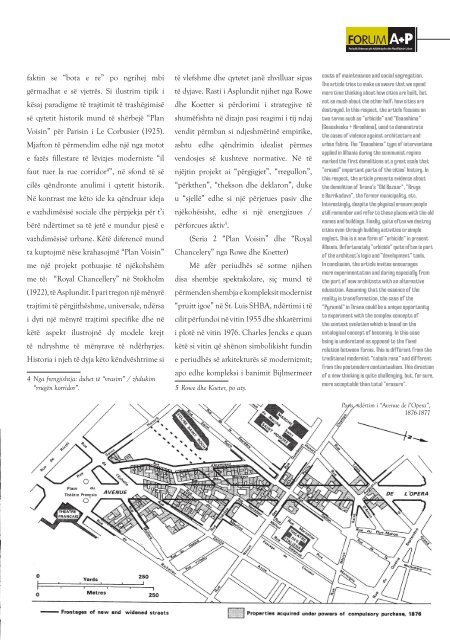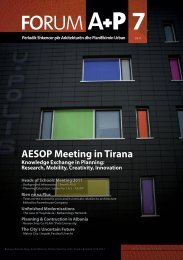Forum A+P 08
POLIS University publishes the “Forum A+P” journal, the only scientific and cultural magazine in the Albanian –speaking countries for the fields of architecture and territory planning. This magazine is recognized by the Ministry of Education and Science, the Academic Degrees Evaluation Committee and has an ISSN international registration code in France. The magazine is published in Albanian and English language and contains a package of scientific, informative articles and analysis.
POLIS University publishes the “Forum A+P” journal, the only scientific and cultural magazine in the Albanian –speaking countries for the fields of architecture and territory planning. This magazine is recognized by the Ministry of Education and Science, the Academic Degrees Evaluation Committee and has an ISSN international registration code in France. The magazine is published in Albanian and English language and contains a package of scientific, informative articles and analysis.
- No tags were found...
You also want an ePaper? Increase the reach of your titles
YUMPU automatically turns print PDFs into web optimized ePapers that Google loves.
faktin se “bota e re” po ngrihej mbi<br />
gërmadhat e së vjetrës. Si ilustrim tipik i<br />
kësaj paradigme të trajtimit të trashëgimisë<br />
së qytetit historik mund të shërbejë “Plan<br />
Voisin” për Parisin i Le Corbusier (1925).<br />
Mjafton të përmendim edhe një nga motot<br />
e fazës fillestare të lëvizjes moderniste “il<br />
faut tuer la rue corridor 4 ”, në sfond të së<br />
cilës qëndronte anulimi i qytetit historik.<br />
Në kontrast me këto ide ka qëndruar ideja<br />
e vazhdimësisë sociale dhe përpjekja për t’i<br />
bërë ndërtimet sa të jetë e mundur pjesë e<br />
vazhdimësisë urbane. Këtë diferencë mund<br />
ta kuptojmë nëse krahasojmë “Plan Voisin”<br />
me një projekt pothuajse të njëkohshëm<br />
me të: “Royal Chancellery” në Stokholm<br />
(1922), të Asplundit. I pari tregon një mënyrë<br />
trajtimi të përgjithëshme, universale, ndërsa<br />
i dyti një mënyrë trajtimi specifike dhe në<br />
këtë aspekt ilustrojnë dy modele krejt<br />
të ndryshme të mënyrave të ndërhyrjes.<br />
Historia i njeh të dyja këto këndvështrime si<br />
4 Nga frengjishtja: duhet të “vrasim” / zhdukim<br />
“rrugën korridor”.<br />
të vlefshme dhe qytetet janë zhvilluar sipas<br />
të dyjave. Rasti i Asplundit njihet nga Rowe<br />
dhe Koetter si përdorimi i strategjive të<br />
shumëfishta në dizajn pasi reagimi i tij ndaj<br />
vendit përmban si ndjeshmërinë empirike,<br />
ashtu edhe qëndrimin idealist përmes<br />
vendosjes së kushteve normative. Në të<br />
njëjtin projekt ai “përgjigjet”, “rregullon”,<br />
“përkthen”, “thekson dhe deklaron”, duke<br />
u “sjellë” edhe si një përjetues pasiv dhe<br />
njëkohësisht, edhe si një energjizues /<br />
përforcues aktiv 5 .<br />
(Seria 2 “Plan Voisin” dhe “Royal<br />
Chancelery” nga Rowe dhe Koetter)<br />
Më afër periudhës së sotme njihen<br />
disa shembje spektakolare, siç mund të<br />
përmenden shembja e kompleksit modernist<br />
“pruitt igoe” në St. Luis SHBA, ndërtimi i të<br />
cilit përfundoi në vitin 1955 dhe shkatërrimi<br />
i plotë në vitin 1976. Charles Jencks e quan<br />
këtë si vitin që shënon simbolikisht fundin<br />
e periudhës së arkitekturës së modernizmit;<br />
apo edhe kompleksi i banimit Bijlmermeer<br />
5 Rowe dhe Koeter, po aty.<br />
costs of maintenance and social segregation.<br />
The article tries to make us aware that we spend<br />
more time thinking about how cities are built, but<br />
not so much about the other half: how cities are<br />
destroyed. In this respect, the article focuses on<br />
two terms such as “urbicide” and “Ceaoshima”<br />
(Ceaoshesku + Hiroshima), used to demonstrate<br />
the cases of violence against architecture and<br />
urban fabric. The “Ceaoshima” type of interventions<br />
applied in Albania during the communist regime<br />
marked the first demolitions at a great scale that<br />
“erased” important parts of the cities’ history. In<br />
this respect, the article presents evidence about<br />
the demolition of Tirana’s “Old Bazaar”, “Rruga<br />
e Barrikadave”, the former municipality, etc.<br />
Interestingly, despite the physical erasure people<br />
still remember and refer to these places with the old<br />
names and buildings. Finally, quite often we destroy<br />
cities even through building activities or simple<br />
neglect. This is a new form of “urbicide” in present<br />
Albania. Unfortunately “urbicide” quite often is part<br />
of the architect’s logic and “development” tools.<br />
In conclusion, the article invites encourages<br />
more experimentation and daring especially from<br />
the part of new architects with an alternative<br />
education. Assuming that the essence of the<br />
reality is transformation, the case of the<br />
“Pyramid” in Tirana could be a unique opportunity<br />
to experiment with the complex concepts of<br />
the context evolution which is based on the<br />
ontological concept of becoming. In this case<br />
being is understood as opposed to the fixed<br />
relation between forms. This is different from the<br />
traditional modernist “tabula rasa” and different<br />
from the postmodern contextualism. This direction<br />
of a new thinking is quite challenging, but, for sure,<br />
more acceptable than total “erasure”.<br />
Paris, ndërtim i “Avenue de l’Opera”,<br />
1876-1877





